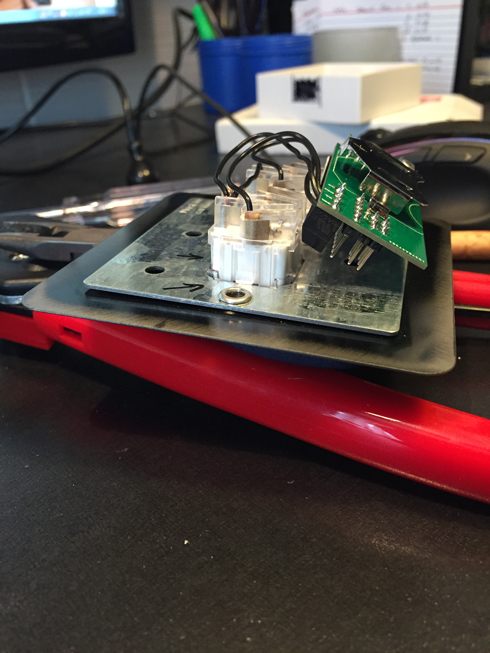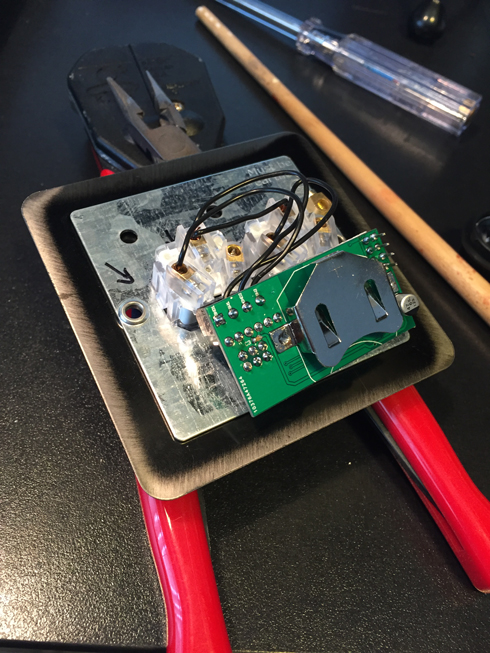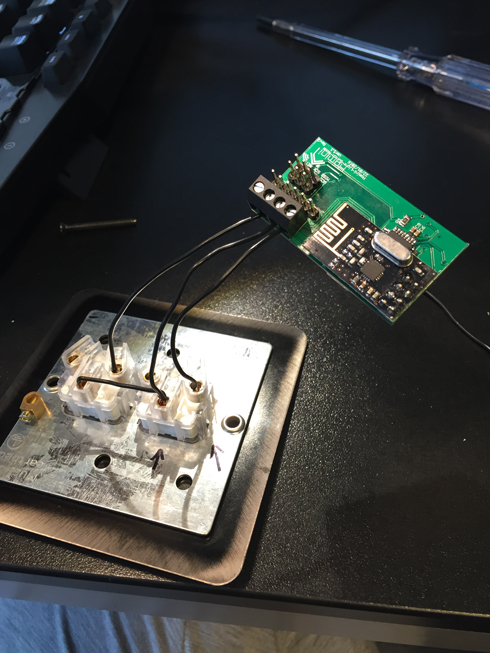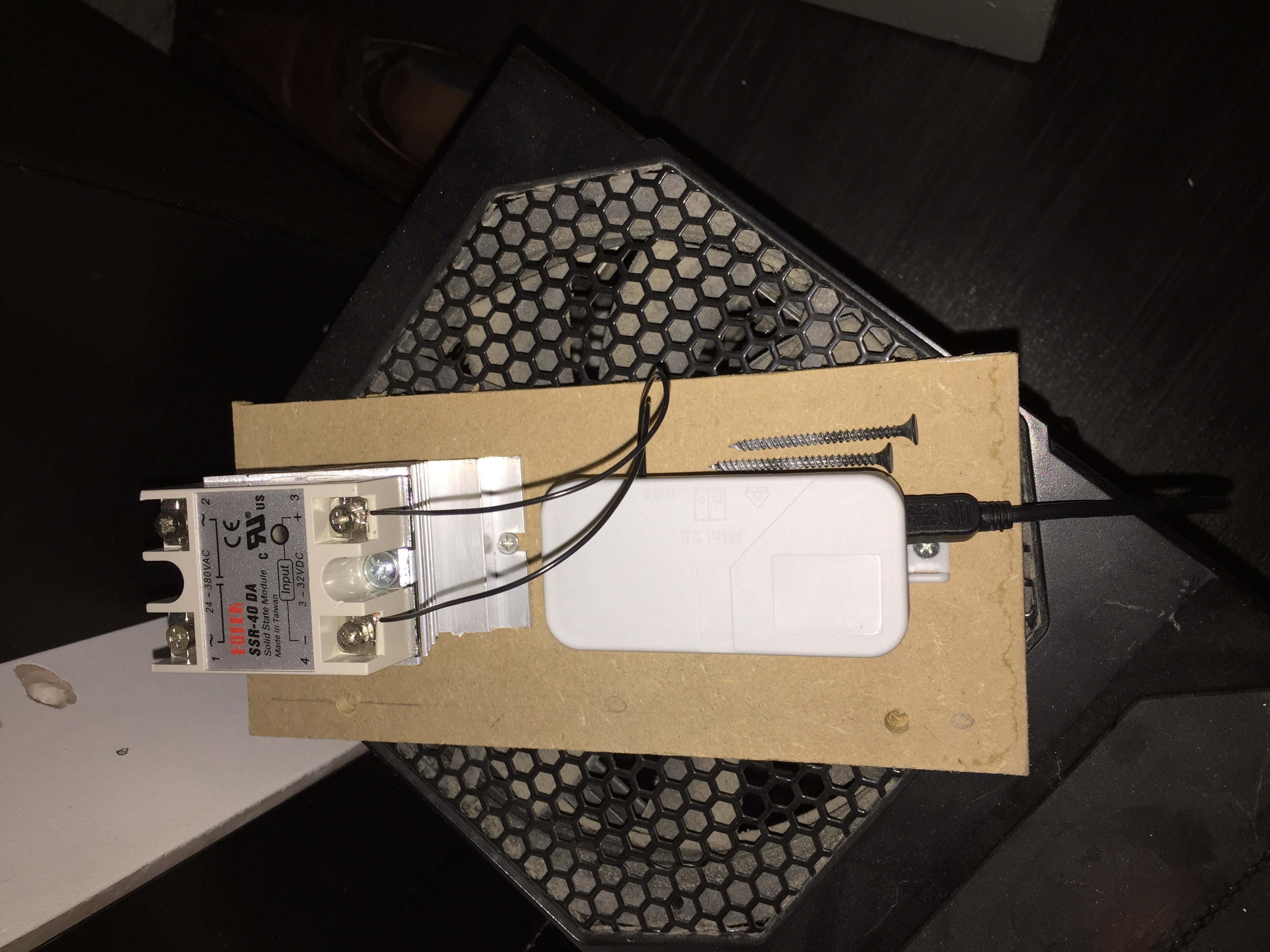In wall light switch node - Custom PCB
-
I'm now sitting with two of these boards in front of me giving me an "Starting sensor (1.6.0-beta), Radio init failed. Check wiring.". As i already have experienced this, i do know that 9/10 times this is hardware related. Normally incorrect wiring. Time to troubleshoot this for the second day. I'm pretty sure that i have no shorts on the board, the only thing that i can think it could be is a broken radio, but with the two doing this i'm a little skeptical about that.
-
So here we have it guys, Revision 2 is now complete, tested and working perfectly! Its been a grueling process but so rewarding. I plan on making a few tiny little changes, including some headers/jumpers to allow ISP uploads while the radio is attached and pull-up resistors to the switch lines. I will get these all ironed out in the next few days and get the designs sent off to get the final boards manufactured. However, I don't feel that there is a great rush for this last board as the upgrades are very minor ones that won't effect its usability right now. The files on the original post are all up to date and relevant including the schematic. I'm yet to test the current draw, I'm trusting that it is sleeping in between the switch toggles, would this be tested via the current draw, if so where should it be measured to confirm this?
Here are a few photographs of the final board attached to a switch plate:



-
Hi,
I'm trying to order this PCB pre-assembled from itead.cc, but it requires Gerber and BOM files, none of which are found in the Eagle files zip...
Any idea how can I get this PCB pre-assembled?
-
Hi,
I'm trying to order this PCB pre-assembled from itead.cc, but it requires Gerber and BOM files, none of which are found in the Eagle files zip...
Any idea how can I get this PCB pre-assembled?
I'm affraid i don't have this board set up with any distributor for pre-assembly sales. The only option to get this board pre made would be for me (or anyone else willing to build the board) to build the board for you then mail to you. I can supply you with the gerber files and everything needed to purchase the board and a BOM then you can build the board yourself if thats possible.
-
I'm affraid i don't have this board set up with any distributor for pre-assembly sales. The only option to get this board pre made would be for me (or anyone else willing to build the board) to build the board for you then mail to you. I can supply you with the gerber files and everything needed to purchase the board and a BOM then you can build the board yourself if thats possible.
@samuel235
That is a shame, this looks like exactly what I was looking for, though the assembly is way over my head. This is why I was hoping to get it pre-assembled...I can handle the basic soldering of a capacitor or varistor, but not their miniature versions, not to mention the atmega chip...
-
I'm affraid i don't have this board set up with any distributor for pre-assembly sales. The only option to get this board pre made would be for me (or anyone else willing to build the board) to build the board for you then mail to you. I can supply you with the gerber files and everything needed to purchase the board and a BOM then you can build the board yourself if thats possible.
@samuel235 said:
I'm affraid i don't have this board set up with any distributor for pre-assembly sales. The only option to get this board pre made would be for me (or anyone else willing to build the board) to build the board for you then mail to you. I can supply you with the gerber files and everything needed to purchase the board and a BOM then you can build the board yourself if thats possible.
I'd appreciate the gerber and BOM files, though!
Could you add a link to them in the first post? -
@samuel235 said:
I'm affraid i don't have this board set up with any distributor for pre-assembly sales. The only option to get this board pre made would be for me (or anyone else willing to build the board) to build the board for you then mail to you. I can supply you with the gerber files and everything needed to purchase the board and a BOM then you can build the board yourself if thats possible.
I'd appreciate the gerber and BOM files, though!
Could you add a link to them in the first post?@Sefi-Ninio - Soon as i get home from work tonight i will get that sorted for you. However i do advise you waiting for revision 3 to come out as currently a new sketch/program can't be uploaded to the uC while the radio is attached.
-
@Sefi-Ninio - Soon as i get home from work tonight i will get that sorted for you. However i do advise you waiting for revision 3 to come out as currently a new sketch/program can't be uploaded to the uC while the radio is attached.
@samuel235 said:
@Sefi-Ninio - Soon as i get home from work tonight i will get that sorted for you. However i do advise you waiting for revision 3 to come out as currently a new sketch/program can't be uploaded to the uC while the radio is attached.
Thanks!
When do you think rev. 3 will come out and tested? -
Depending on my full-time job workload, I'm hoping to have the designs completed and sent off for manufacturing by sunday, but then we face the 3 week wait for the shipping, and then the testing +/- a week for constant testing measures.
-
Other than re-designing pretty much all of my board to allow for jumpers on the SPI lines that collide with the nRF24 lines, to allow for SPI uploads, how else would you go about this?
The other option would be to run with a 8MHz external crystal to allow my FTDI Serial header to upload sketches. Which if i'm honest, I'de rather not do due to power consumption (If it was a case of using a 16MHz crystal the power consumption would be worth the clock speed increase to get the uC back to sleep quicker, but on wake the uC only have one thing to process then it will go back to sleep anyway, it isn't like it has a lot to process before sleeping again).
-
OK then,
But a thought: if instead of soldering the radio to the PCB, we solder female pins? That way we can easily detach the radio when we want to flush new sketch and attach again. -
OK then,
But a thought: if instead of soldering the radio to the PCB, we solder female pins? That way we can easily detach the radio when we want to flush new sketch and attach again.@Sefi-Ninio - This was a plan of mine right from the start as stated in a few of the early comments. However, to me, this is not an option due to the height restrictions on the board. I really want to keep this as thin as possible to accommodate for various 'new' style switches that take up more than normal ones in terms of the depth of the back box.
I would turn the radio round and stack it on top of the coin-cell but i do not want to be battling with any interference, it will have enough to contend with being nested inside of a metal backbox as it is.
-
@Sefi-Ninio - This was a plan of mine right from the start as stated in a few of the early comments. However, to me, this is not an option due to the height restrictions on the board. I really want to keep this as thin as possible to accommodate for various 'new' style switches that take up more than normal ones in terms of the depth of the back box.
I would turn the radio round and stack it on top of the coin-cell but i do not want to be battling with any interference, it will have enough to contend with being nested inside of a metal backbox as it is.
@samuel235
While we're on the subject of switches - how is it that you are able to control the switch without a relay on board? -
@samuel235
While we're on the subject of switches - how is it that you are able to control the switch without a relay on board?The light switch board itself sends a signal to my controller, that then triggers my other node (relay with button actuator node) to toggle on or off. I've attached a image of my other node that we speak about here that the one side of the relay is connected to my lighting circuit and then i have another switch connected to that node to be able to locally switch the light in case the controller goes down for some unknown reason.

-
So here we have it guys, Revision 2 is now complete, tested and working perfectly! Its been a grueling process but so rewarding. I plan on making a few tiny little changes, including some headers/jumpers to allow ISP uploads while the radio is attached and pull-up resistors to the switch lines. I will get these all ironed out in the next few days and get the designs sent off to get the final boards manufactured. However, I don't feel that there is a great rush for this last board as the upgrades are very minor ones that won't effect its usability right now. The files on the original post are all up to date and relevant including the schematic. I'm yet to test the current draw, I'm trusting that it is sleeping in between the switch toggles, would this be tested via the current draw, if so where should it be measured to confirm this?
Here are a few photographs of the final board attached to a switch plate:



@samuel235 said:
So here we have it guys, Revision 2 is now complete, tested and working perfectly! Its been a grueling process but so rewarding. I plan on making a few tiny little changes, including some headers/jumpers to allow ISP uploads while the radio is attached and pull-up resistors to the switch lines. I will get these all ironed out in the next few days and get the designs sent off to get the final boards manufactured. However, I don't feel that there is a great rush for this last board as the upgrades are very minor ones that won't effect its usability right now. The files on the original post are all up to date and relevant including the schematic. I'm yet to test the current draw, I'm trusting that it is sleeping in between the switch toggles, would this be tested via the current draw, if so where should it be measured to confirm this?
Here are a few photographs of the final board attached to a switch plate:



But here, you show the PCB connected directly to the switch, right?
-
Indeed this is. However I have two switches for this light setup. So, this board is essentially a slave device for the light itself. The relay module that i just posted a picture of is connected to another switch with two length of wire/cable, one connected to GND and the other connected to pin 3. The relay module itself uses the RelayWithButtonActuator sketch, then i can use the local switch and this slave board to control the lighting.
-
OK, so if I get you correctly, the wall switch, when turned on, is detected by the slave module that updates the gateway, which in turn issues a command to the relay module to turn the light on/off. And the slave module detects the switch state change because it makes or breaks the connection.
Correct?That is a smart approach! But for each light you have 2 modules (slave on the switch side and relay on the lamp itself)... That can sum up to a lot of nodes for the entire property...
More so considering a light with 4 way switch (3 different switches that can turn it on/off) - that would require 3 slave modules and a relay module.Also - what are the expectations for battery drain?
-
OK, so if I get you correctly, the wall switch, when turned on, is detected by the slave module that updates the gateway, which in turn issues a command to the relay module to turn the light on/off. And the slave module detects the switch state change because it makes or breaks the connection.
Correct?That is a smart approach! But for each light you have 2 modules (slave on the switch side and relay on the lamp itself)... That can sum up to a lot of nodes for the entire property...
More so considering a light with 4 way switch (3 different switches that can turn it on/off) - that would require 3 slave modules and a relay module.Also - what are the expectations for battery drain?
@Sefi-Ninio If i understand you correctly, you are correct. However, not every light needs two modules, this has two because i want two switches for this light. For a light that needs only one switch i use the locally connected switch on the relay node itself.
I'll sort out a rough diagram later illustrating this.
-
@Sefi-Ninio If i understand you correctly, you are correct. However, not every light needs two modules, this has two because i want two switches for this light. For a light that needs only one switch i use the locally connected switch on the relay node itself.
I'll sort out a rough diagram later illustrating this.
@samuel235
Thanks, I'd really appreciate that!Saw you added the gerber files, thanks for that. Could you also provide the BOM file?
a couple more questions, if you don't mind:- Do you know how long the battery is expected to last before it needs to be replaced?
- Does the module support GPIO pins as well, for some sensors to be connected?
Thanks again for taking your time to help!
-
@samuel235
Thanks, I'd really appreciate that!Saw you added the gerber files, thanks for that. Could you also provide the BOM file?
a couple more questions, if you don't mind:- Do you know how long the battery is expected to last before it needs to be replaced?
- Does the module support GPIO pins as well, for some sensors to be connected?
Thanks again for taking your time to help!
@Sefi-Ninio - I will get the BOM uploaded when i get home again. This full-time job really does get in the way of my 'MySensors Life' ahaha. I'm sorry, i forgot to get the BOM last night.
To answer your questions:
-
The only calculations i've done are based on Maniacs workings regarding coin cell powering the uC with an led and rf module. He worked out it should last as long as the battery does, he claimed it used less power than the battery discharge rate. So around 1 year 4 months he calculated. With my current plans for revision 3 having an external 8MHz crystal on board, it should still remain at around that length of time.
-
It doesn't unfortunately since this was designed to be a minimal sized board that fits in the most shallow socket box I work with, i'm a building (plasterer and tiler) by trade and as this is the smallest back box we generally use in the building trade i wanted it to fit in without issues. It was designed to be just a light switch, i did have enitial thoughts to be able to interface the switch with a motion detector and even a temperature sensor to feed back to the controller the temp for the room. But i have a much bigger and more productive module in the design phases at the moment to handle this for each room. I will release another thread based on this new module soon.
